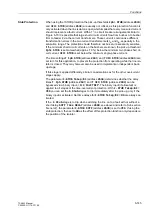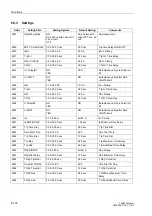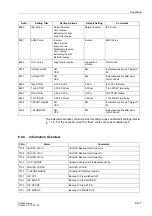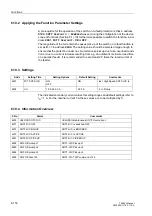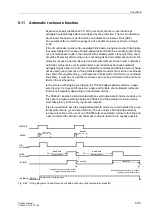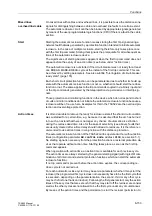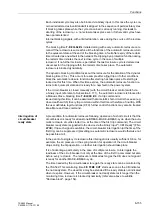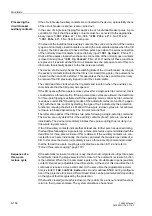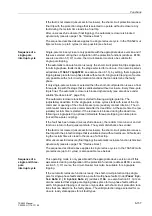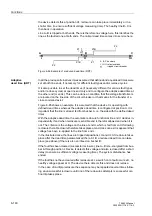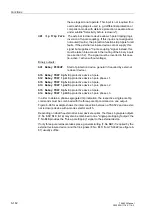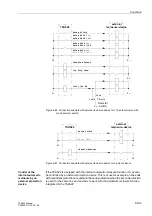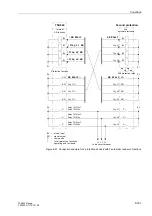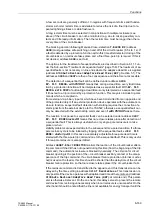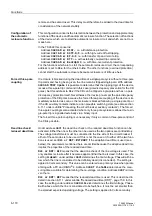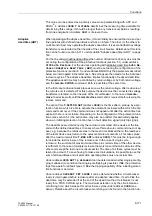
Functions
6-156
7SA522 Manual
C53000-G1176-C119-2
Processing the
circuit breaker
auxiliary contacts
If the circuit-breaker auxiliary contacts are connected to the device, a plausibility check
of the circuit-breaker response is also carried out.
In the case of single pole tripping this applies to each individual breaker poles. A pre-
condition for this is that the auxiliary contacts must be connected to the appropriate
binary inputs ("
"
If in stead of the individual pole auxiliary contacts, the series connection of the normal-
ly open and normally closed contacts are used (the normal state applies when the CB
is open), the CB is assumed to have all three poles open when the series connection
of the normally closed contacts is closed (binary input "
“, F.No. 411).
It has all three poles closed when the series connection of the normally open contacts
is closed (binary input "
“, F.No. 410). If neither of these conditions
are present, it is assumed that the circuit breaker has one pole open (even if this con-
dition also theoretically applies to the two-pole open state).
The device continuously checks the switching state of the circuit-breaker: As long as
the auxiliary contacts indicate that the CB is not closed (three-pole), the automatic re-
closure function cannot be started. This guarantees that a close command can only
be issued if the CB previously tripped (out of the closed state).
The valid dead time starts when the trip command resets or when the auxiliary con-
tacts indicate that the CB (pole) has opened.
If the CB opens with
three-
pole reclose cycles after a
single
pole trip command, this is
considered as a three-pole trip. If three-pole reclose cycles are allowed, the dead time
for three-pole tripping is activated with the operating mode: control by trip command
(see above under title "Operating modes of the automatic reclosure function", page 6-
152); with the mode: control by starting, the type of fault indicated by the protection
function(s) issueing the start is still valid. If three-pole reclose cycles are not allowed,
reclosure is blocked dynamically. The trip command is final.
The latter also applies if the CB trips two poles following a single-pole trip command.
The device can only detect this if the auxiliary contacts of each pole are connected
individually. The device immediately initiates three pole coupling thus resulting in a
three-pole trip command.
If the CB auxiliary contacts indicate that at least one further pole has opened during
the dead time following a single-pole trip, a three-pole reclose cycle is initiated with the
dead time for three-pole reclosure if this is allowed. If the auxiliary contacts are con-
nected for each pole individually, the device can detect the two-pole open state of a
CB. In this case the device immediately issues a three-pole trip command provided
that the forced three-pole coupling is activated (see section 6.11.2 and refer to
"Forced three-pole coupling", page 170).
Sequence of a
three-pole
reclose cycle
If the automatic reclosure function is ready, the short-circuit protection trips three pole
for all faults inside the stage selected for reclosure. The automatic reclosure function
is then started. When the trip command resets or the circuit-breaker opens (auxiliary
contact criterion) an (adjustable) dead time starts. At the end of this dead time the cir-
cuit-breaker receives a close command. At the same time the (adjustable) reclaim
time is started. If
$5FRQWUROPRGH
was set under address
during configura-
tion of the protective functions, different dead times can be parameterized depending
on the type of fault recognised by the protection.
If the fault is cleared (successful reclosure), the reclaim time runs out and all functions
return to their quiescent state. The system disturbance has ended.
Summary of Contents for siprotec 7SA522
Page 20: ...7SA522 Manual C53000 G1176 C119 2 ...
Page 64: ...7SA522 Manual C53000 G1176 C119 2 ...
Page 89: ...SIPROTEC 4 Devices 4 25 7SA522 Manual C53000 G1176 C119 2 Figure 4 20 CFC Logic example ...
Page 408: ...7SA522 Manual C53000 G1176 C119 2 ...
Page 456: ...7SA522 Manual C53000 G1176 C119 2 ...
Page 516: ...7SA522 Manual C53000 G1176 C119 2 ...
Page 620: ...Appendix B 48 ...




